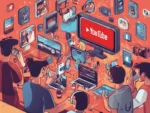Content marketing ROI matters. As marketing budgets face increased scrutiny, proving the financial impact of your content has never been more critical. With content marketing generating significantly higher ROI than traditional methods, tracking your returns is essential.
The challenge isn’t just tracking content marketing metrics. It’s knowing which numbers truly matter and how they translate to actual business value. Without this clarity, your content marketing remains a cost center rather than a profit driver in the eyes of your organization’s leadership.
This guide tackles the content marketing ROI challenge head-on. I’ll show you exactly how to calculate, track, and optimize your content’s return on investment using proven methods. You’ll learn which metrics matter most, how to implement proper attribution, and how to communicate results effectively to stakeholders.
Let’s transform your content marketing from a necessary expense into a measurable revenue generator.
Understanding Content Marketing ROI
Content marketing ROI represents the tangible business returns generated from your content investments. It goes beyond vanity metrics like page views or social shares to measure actual business impact. Proper ROI measurement connects content directly to revenue generation, cost savings, or other defined business objectives.

Why is this measurement so crucial? Documentation challenges present a significant obstacle, with 33% of marketers reporting difficulty measuring ROI due to data integration issues.
Despite these challenges, the business case for content marketing remains compelling. Content marketing generates three times more leads per dollar spent than traditional advertising methods when properly implemented.
What makes effective content marketing examples often comes down to strategic planning and careful measurement. The disconnect between content activities and business results typically stems from improper measurement frameworks.
Many marketers track what’s easy rather than what’s meaningful. Others fail to account for the full cost of content creation. Some expect immediate returns from what is fundamentally a long-term strategy.
Effective ROI measurement requires patience, consistent tracking, and a clear understanding of how content contributes to your business objectives. Let’s explore how to calculate this critical metric properly.
The Basic Content Marketing ROI Formula
The foundation of content marketing ROI measurement starts with a straightforward formula. At its core, ROI calculation follows this basic structure:
ROI = ((Revenue from Content – Content Cost) / Content Cost) × 100
This formula yields a percentage that represents your return. For example, if you invest $500 in creating and promoting content that generates $2,000 in revenue, your ROI would be 300%.
While the formula seems simple, both components require careful consideration. Let’s examine the key elements that go into an accurate ROI calculation.
| Formula Component | What to Include | Common Mistakes |
|---|---|---|
| Revenue from Content | Direct sales, lead value, subscription revenue, ad revenue | Counting only direct sales, ignoring lead value |
| Content Cost | Creation costs, distribution expenses, staff time, tools, management overhead | Only counting external production costs |
| Calculation Timeframe | Short-term and long-term measurement periods | Expecting immediate returns for all content types |
| Attribution Approach | First-touch, last-touch, multi-touch models | Using only last-touch attribution |
Accurate ROI calculation requires honest assessment of both sides of the equation. Many marketers underestimate their true content costs by failing to account for internal resources, management time, and technology investments. Similarly, they may overlook certain revenue streams or the long-term value content creates.
For most businesses, content marketing produces both direct and indirect returns. Direct returns include sales, lead generation, and subscription revenue. Indirect returns might include brand awareness, customer loyalty, reduced support costs, and improved hiring outcomes.
Remember that different content types deliver value on different timelines. Blog posts might drive immediate lead generation while thought leadership content builds valuable credibility over months or years. Your ROI calculation should reflect these varying horizons.
Essential Metrics for Tracking Content Marketing ROI
Effective content marketing ROI measurement requires tracking multiple metrics that collectively tell the complete performance story. These metrics fall into several key categories, each contributing important pieces to your ROI puzzle.
The most valuable metrics connect directly to business outcomes rather than simply measuring content consumption. While page views and social shares provide some insight, conversion metrics and revenue indicators offer far more value for ROI calculation.
Understanding how content marketing impacts your sales funnel is crucial for comprehensive ROI measurement. Let’s explore the essential metrics you should monitor to accurately measure your content marketing ROI:
Overwhelmed by Digital Marketing?
Just released: my new book to help small businesses, entrepreneurs, and marketers master digital marketing in today’s digital-first world.
Drawing on my Fractional CMO experience, Digital Threads simplifies complex strategies into clear, actionable steps for success.
Transform your business today—grab your copy! Click the cover or button below to buy on Amazon.
| Metric Category | Specific Metrics | ROI Relevance | Measurement Tools |
|---|---|---|---|
| Conversion Metrics | Conversion rate, form completions, email signups, sales | Directly ties content to business outcomes | Google Analytics, CRM systems |
| Engagement Metrics | Time on page, pages per session, bounce rate, scroll depth | Indicates content quality and relevance | Google Analytics, heat mapping tools |
| Revenue Metrics | Revenue attributed to content, CLV, average order value | Shows direct financial impact | CRM, ecommerce platforms |
| Cost Metrics | Cost per lead, cost per acquisition, content production costs | Reveals efficiency of content investment | Project management tools, financial systems |
Conversion rate serves as a particularly valuable metric, showing the percentage of visitors who take desired actions after consuming your content. This metric helps measure content effectiveness in driving specific business goals.
Different content types often require different measurement approaches. Here are the top metrics to consider based on content format:
- Blog Posts – Conversion rate, organic traffic, backlinks, time on page, lead generation
- Video Content – View duration, conversion actions, shares, viewer retention rates
- Email Newsletters – Open rates, click-through rates, conversions, subscriber growth
- Social Media Content – Engagement rate, click-throughs, conversions, audience growth
- Premium Content (eBooks, Guides) – Download rate, lead quality, sales influence, usage metrics
Customer Lifetime Value (CLV) deserves special attention in your measurement framework. This metric helps you understand the long-term revenue impact of content-acquired customers, providing crucial context for your ROI calculations. Tracking CLV often requires integration between your content analytics and CRM data.
For comprehensive ROI tracking, develop a measurement framework that includes metrics from each category. Focus on metrics that align with your specific business objectives rather than trying to track everything. This targeted approach ensures your measurement efforts remain manageable while providing meaningful insights.
Attribution Modeling for Content Marketing
Attribution modeling represents one of the most challenging aspects of content marketing ROI calculation. The customer journey rarely follows a linear path, with most buyers consuming multiple content pieces before making a purchase decision. Attribution models help determine how much credit each content touchpoint receives for conversions.
Selecting the right attribution model fundamentally impacts your ROI calculations. Different models distribute conversion credit in different ways, potentially leading to vastly different ROI conclusions for the same content assets.
The following table compares common attribution models and their implications for content marketing ROI:
| Attribution Model | How It Works | Best For | Limitations |
|---|---|---|---|
| First-Touch | Assigns 100% credit to the first content interaction | Awareness-focused content, top-of-funnel evaluation | Ignores all subsequent content contributions |
| Last-Touch | Gives all credit to the final touchpoint before conversion | Bottom-of-funnel, conversion-focused content | Misses earlier influential touchpoints |
| Linear | Distributes credit equally across all touchpoints | Understanding the full content journey | Doesn’t weigh touchpoints by impact |
| Position-Based | Gives 40% to first touch, 40% to last touch, 20% to middle touchpoints | Balanced view of awareness and conversion content | May overvalue first and last interactions |
| Time-Decay | Assigns more credit to touchpoints closer to conversion | Longer sales cycles with multiple content interactions | Undervalues early-stage content |
| Data-Driven | Uses algorithms to distribute credit based on impact patterns | Mature content programs with sufficient data | Requires significant data and technical resources |
Most successful content marketing programs implement multi-touch attribution models that acknowledge the role of different content pieces throughout the buyer’s journey. Research shows that 54% of companies measure content marketing ROI using leads, conversions, and revenue as primary metrics, highlighting the importance of connecting content to tangible business outcomes through proper attribution.
When selecting an attribution model, consider your typical customer journey length, the variety of content types in your strategy, and your business objectives. Companies with longer sales cycles often benefit from position-based or time-decay models, while businesses with simpler purchasing paths might find first-touch or last-touch models sufficient.
Remember that no attribution model is perfect. The goal is not perfect attribution but rather consistent measurement that provides actionable insights about your content’s performance. Many sophisticated marketing teams use multiple attribution models simultaneously to gain different perspectives on their content’s impact.
Calculating True Content Costs
Accurate content marketing ROI calculation depends as much on understanding your true costs as it does on tracking revenue. Many marketers significantly underestimate their content investments by focusing solely on direct production expenses while overlooking numerous hidden costs.
Comprehensive cost calculation requires accounting for every resource involved in your content marketing efforts. This includes obvious expenses like freelancer payments and also less visible investments like staff time, technology infrastructure, and management overhead.
When calculating your true content costs, be sure to include these often-overlooked expenses:
- Staff time costs – Include salaries and benefits for everyone who contributes to content (writers, editors, designers, strategists, subject matter experts)
- Management overhead – Factor in time spent planning, reviewing, and managing content projects
- Technology investments – Prorate costs for content management systems, analytics tools, design software, and other technology
- Distribution expenses – Include paid promotion, email marketing costs, and social media management
- Outsourced services – Account for agencies, freelancers, and specialized content services
For proper ROI calculations, you must include staff salaries and all production costs, not just external expenses. Many organizations overlook internal resource allocation when evaluating content performance.
The most accurate approach divides costs into fixed and variable components. Fixed costs include your baseline content team, technology platforms, and ongoing investments. Variable costs change based on specific campaigns, content types, or production requirements.
Consider using a project management system that tracks time investments across your team. This provides valuable data for calculating the true cost of different content types and helps identify efficiency opportunities. For organizations without formal time tracking, periodic audits or estimates can provide useful approximations.
When evaluating ROI for specific content pieces or campaigns, you’ll need to decide whether to include both fixed and variable costs or focus only on incremental expenses. Including all costs provides a more complete picture but may make high-quality, resource-intensive content appear less profitable in the short term.
The goal isn’t to minimize content costs but rather to understand them fully. This transparency enables more strategic resource allocation and helps justify continued or increased content investments based on proven returns.

Tools for Measuring Content Marketing ROI
Effective content marketing ROI measurement requires the right tools to track, analyze, and report on performance. The technology landscape offers numerous options ranging from free analytics platforms to sophisticated marketing attribution solutions.
The ideal measurement stack combines tools that track different aspects of the content journey while integrating data for comprehensive analysis. For most organizations, this includes web analytics, CRM systems, marketing automation platforms, and specialized content performance tools.
Here’s a comparison of key tool categories for measuring content marketing ROI:
| Tool Category | Key Functions | Popular Options | Implementation Complexity |
|---|---|---|---|
| Web Analytics | Track traffic, engagement, conversions | Google Analytics, Adobe Analytics | Low to Medium |
| CRM Systems | Connect content to leads, opportunities, revenue | Salesforce, HubSpot, Pipedrive | Medium to High |
| Marketing Automation | Track engagement across channels, lead nurturing | HubSpot, Marketo, Pardot | Medium to High |
| Content-Specific Analytics | Detailed content performance tracking | Parse.ly, ContentSquare, Conductor | Medium |
| Attribution Solutions | Multi-touch attribution modeling | Bizible, Attribution, Dreamdata | High |
| SEO Platforms | Organic search performance, content opportunities | Semrush, Ahrefs, Moz | Low to Medium |
Google Analytics represents the foundational measurement tool for most content programs, offering robust tracking for traffic and conversion metrics. For more advanced lead tracking, particularly in B2B contexts, platforms like HubSpot provide comprehensive measurement capabilities.
The right tool mix depends on your content objectives, business model, and available resources. Start with the essentials and expand your measurement stack as your content program matures. For most organizations, this means beginning with web analytics and gradually adding CRM integration, specialized content metrics, and eventually attribution modeling.
Creating a content calendar helps organize your ROI tracking efforts and ensures consistent measurement across all your content initiatives. With proper planning, you can align your measurement schedule with content publication for more accurate tracking.
Tool implementation should follow a phased approach:
First, set up basic tracking for all content (traffic, time on page, conversions). Then implement goal tracking aligned with business objectives. Next, create consistent UTM parameters for campaign tracking. After that, connect web analytics with CRM/sales data. Finally, develop custom reports for regular ROI monitoring.
Remember that tools themselves don’t generate ROI—they simply help measure it. The true value comes from analyzing the data these tools provide and taking action to optimize your content strategy based on performance insights.
Common Content ROI Measurement Pitfalls
Even with the right formula and tools in place, content marketing ROI measurement can go astray. Several common pitfalls undermine accurate performance assessment and lead to misguided strategic decisions. Recognizing these challenges is the first step toward more reliable ROI measurement.
One of the most prevalent mistakes is overreliance on vanity metrics that look impressive but reveal little about actual business impact. Research shows that 50% of marketers prioritize social media engagement over conversions when measuring content success, focusing on metrics that don’t necessarily translate to revenue.
Watch for these warning signs that your ROI measurement approach might be flawed:
- Focusing exclusively on traffic metrics – High traffic with low conversion rates often indicates content-audience mismatch
- Expecting immediate returns from all content – Different content types produce value on different timelines
- Using inconsistent measurement timeframes – Constantly changing measurement periods makes trend analysis impossible
- Ignoring content’s influence on offline conversions – Many content-influenced purchases occur through non-digital channels
- Measuring content in isolation from other marketing – Content often works in conjunction with other marketing efforts
Short-term measurement bias represents another significant challenge. Many marketers expect immediate returns from what is essentially a long-term investment. While some content formats can generate quick wins, the compound value of consistent content creation often takes months to fully materialize.
Attribution challenges also complicate accurate measurement. When prospects interact with multiple content pieces across various channels before converting, determining which content deserves credit becomes complex. This complexity increases with longer sales cycles and more touchpoints.
Inconsistent tracking presents yet another obstacle. As marketing teams evolve, tracking methods often change, making year-over-year comparisons difficult. Establish consistent measurement frameworks that can withstand team changes and tool transitions to maintain data continuity.
Finally, many organizations struggle with data silos that prevent holistic ROI assessment. When content analytics, CRM data, and sales information exist in separate systems without integration, developing a complete picture of content performance becomes nearly impossible.
To overcome these challenges, develop a measurement framework that balances short and long-term metrics, integrates data from multiple sources, and maintains consistency over time. Focus on the metrics that most directly connect to your business objectives rather than tracking everything possible.
Optimizing Your Content for Better ROI
Once you’ve established a solid ROI measurement framework, the next step is using those insights to continuously improve performance. Content optimization represents one of the most cost-effective ways to increase ROI without expanding your budget.
Strategic content optimization starts with a thorough content audit. This process identifies your highest and lowest-performing content assets, revealing opportunities for improvement and informing future content investments. Updating old content can drive 40%+ organic traffic growth, often delivering better ROI than creating entirely new content.
Consider these quick-win optimization tactics to boost your content marketing ROI:
- Improve conversion elements – Optimize calls-to-action, lead forms, and other conversion points
- Update high-potential but underperforming content – Refresh outdated information, improve readability, add new insights
- Repurpose successful content into multiple formats – Transform high-ROI blog posts into videos, infographics, or email sequences
- Enhance content distribution – Test new promotion channels for existing high-value content
- Address SEO opportunities – Optimize underperforming but high-potential content for relevant keywords
Diversifying your content mix can also improve overall ROI. Different content types serve different purposes and generate varying returns. Video content, for example, increases website conversion rates by 80% when properly implemented.
Similarly, email marketing continues to deliver exceptional returns, generating $42 for every $1 spent according to industry benchmarks. Integrating email into your content distribution strategy can significantly enhance overall content ROI.
Content optimization should follow a continuous improvement cycle:
Start by measuring performance using your ROI framework. Then identify high-potential optimization opportunities. Next, implement targeted improvements. After that, measure impact against baseline performance. Finally, document learnings and apply to future content.
Focus optimization efforts on content that aligns with your highest-value business objectives. Not all content serves the same purpose, and improvement priorities should reflect your strategic goals. Content directly connected to revenue generation typically deserves more optimization attention than purely informational assets.
Remember that content optimization extends beyond the content itself to include distribution, promotion, and conversion elements. Often, the greatest ROI improvements come not from changing the content but from enhancing how prospects discover and interact with it.
The most successful content marketers maintain a test-and-learn mindset, continually experimenting with new approaches and optimizing based on performance data. This iterative process leads to steadily improving ROI over time.
Reporting Content ROI to Stakeholders
Effective ROI communication proves just as important as measurement itself. Well-structured reporting builds stakeholder confidence, secures continued investment, and positions content marketing as a strategic business function rather than just a creative activity.
Surprisingly, many marketers feel confident in their measurement capabilities, with 59% rating their content ROI measurement as “excellent” or “very good.” However, the ability to translate those measurements into compelling stakeholder communications often lags behind.
When creating ROI reports for executives and stakeholders, include these key elements:
- Business outcomes first – Lead with revenue impact, pipeline influence, or cost savings
- Comparative benchmarks – Show performance relative to industry standards or previous periods
- ROI visualization – Use clear charts and graphics to illustrate returns
- Conversion funnels – Demonstrate how content moves prospects toward purchase
- Forward-looking insights – Share recommendations based on performance data
Tailor your reporting approach to different stakeholder groups. Executives typically care most about bottom-line impact and strategic alignment. Marketing leadership wants to see both outcomes and operational metrics. Content teams need detailed performance data to inform creation and optimization.
Reporting frequency should balance timely insights with meaningful data collection periods. Monthly dashboards provide ongoing visibility, while quarterly in-depth reviews offer more substantial trend analysis. Annual reports should focus on strategic impact and future direction.
Visual presentation significantly impacts how stakeholders perceive your content’s value. Invest time in creating clear, compelling visualizations that instantly communicate performance. Focus on showing trends and comparative data rather than just absolute numbers.
When communicating ROI to secure additional content investment, structure your narrative around:
First, present the initial hypothesis and strategy. Then show resources invested and actions taken. Next, share results achieved with clear ROI calculation. After that, discuss insights gained and lessons learned. Finally, provide recommendations for future investment.
Remember that different content initiatives serve different purposes. Some directly drive revenue, while others build brand authority or support customer retention. Your reporting should acknowledge these varying objectives while still connecting all content activities to business value.
The most compelling ROI reports combine quantitative performance data with qualitative insights and customer feedback. Including customer testimonials or sales team observations alongside metrics creates a more complete picture of content impact.
Conclusion
Calculating content marketing ROI effectively transforms your content strategy from a cost center to a measurable business driver. The process requires clear formulas, comprehensive cost accounting, appropriate attribution models, and consistent measurement frameworks.
The most successful content marketers balance short-term performance indicators with long-term value measurement. They recognize that different content types deliver returns on different timelines and adjust their ROI expectations accordingly.
As content marketing continues evolving, ROI measurement becomes increasingly sophisticated. Forward-thinking marketers are moving beyond basic calculations to develop custom attribution models and integrated measurement systems that capture content’s full business impact.
Remember that content marketing ROI isn’t just about justifying your current budget. It’s about optimizing resource allocation, improving content performance, and making the case for continued investment in your highest-performing content types and channels.
Start with the basic ROI formula we’ve explored, implement proper tracking for both costs and returns, and gradually enhance your measurement approach as your content program matures. Focus on the metrics that most directly connect to your business objectives rather than trying to measure everything.
Most importantly, use your ROI insights to continuously improve your content strategy. The true value of measurement comes not from the numbers themselves but from the strategic decisions they enable. With proper ROI calculation, your content marketing can deliver increasingly powerful business results year after year.
Ready to transform your content marketing measurement? Begin by auditing your current tracking approach against the framework we’ve discussed. Identify gaps in your measurement process and implement the tools and methods needed to calculate your true content marketing ROI.










